Another lovely photo received from our
Forums Sleuth, Mark Dawber (New Zealand), from a forum of old photos
asking for information on the make of vehicle photographed in the
Australian outback? Is it a 1910/12 Alfa 24HP? - - The radiator carries an
ALFA Badge, so an ALFA it is, and it would indeed be from the period
1910/12. ALFA's first car was the 24HP model which was made 1910 to 1921.
We however think that the photo shows from the upright open position of the steering
wheel, also the shape of the scuttle, the bonnet and the radiator, - that it is their smaller model made from 1910 to 1911, being the cca 1911
ALFA 12HP Torpedo Corsa with a four-cylinder engine of 2413cc.
The origins of the ALFA company came
from the ashes of a previous company started in 1906 by Cavalier Stella
called SIAD, Societa Italiana Automobili Darracq, who had built a factory
in Portello Milan to manufacture the French Darracq cars under licence for
the Italian market. The cars were considered 'small' and were not a
success. A new bigger car was under design by Giuseppe Merosi, who had
previously worked for Bianchi and FIAT, when Darracq decided to pull out
of
Italy.
A new group of Italian investors and management decided to buy the
remains, and formed a new organisation called Anonima Lombarde Fabbrica
Automobili - ALFA. Their starting point was the new 24HP car that was
already in the pipeline and which was completely new concept, not
connected to any previous Darracq designs. The prototype was quickly
completed and the new ALFA 24HP was launched in 1910.The ALFA 24 car was an immediate success
and was made in five series over the next 10 years.
|
|
 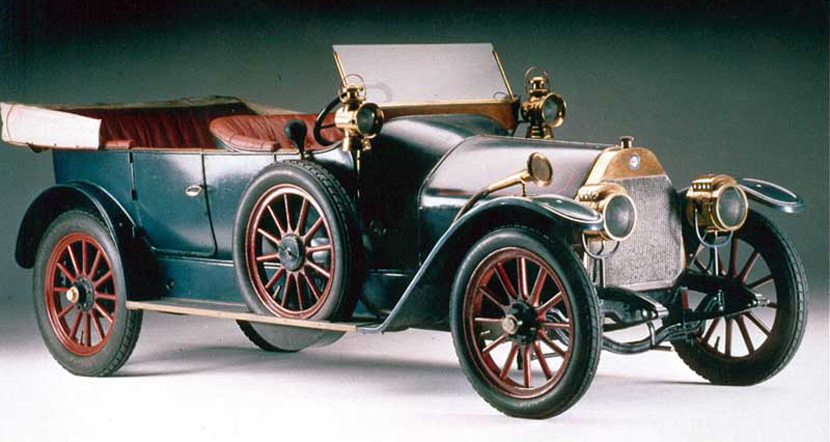
|
It was powered by a
four-cylinder 4100cc engine, had a four-speed gearbox, and was available
as a torpedo tourer, a limousine, or a Baquet (racer). The car was
immediately used for racing, having made its debut in the Targa Florio in
1911. Two vehicles ALFA 24 Tippo Corsa with lightened two-seater bodywork
with 30L fuel tank behind the seats and two spare tyres were built. Cars
had in-line side-valve four-cylinder tuned engines rated 45BHP and were
capable of 110kph (68mph). Cars were driven by Italian drivers; one
crashed and one retired due to physical exhaustion.
At the same time as the ALFA was having
its successes with the ALFA 24, they introduced in 1910 a second, smaller
car, the ALFA 12. This was derived from the 24 but had a smaller
four-cylinder engine of 2413cc, a four-speed gearbox, had drum rear brakes, and
was capable of 56mph. The wheelbase was reduced to 3.2m and it was
available with torpedo tourer bodywork, saloon and as a baquet corsa. A
year later, the Alfa 12 was developed into the ALFA 15 which was a
basically similar chassis same engine but tuned to a higher output, a
three-speed gearbox, and available as either a torpedo or a saloon,
capable of 59mph. These cars were made up to 1913. Within a relatively
short period of 5 years ALFA cars had come to dominate European motorsport
before the outbrake of World War One put an end to motorsport activities.
|
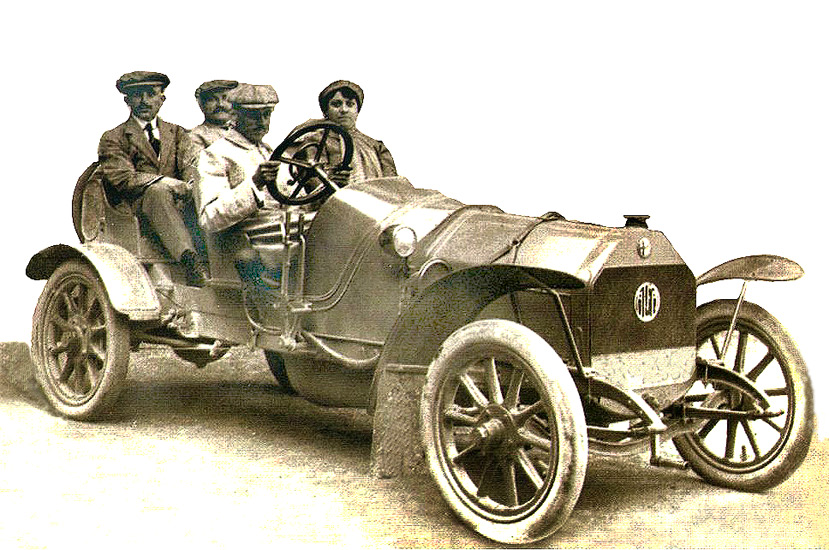 |
The bigger ALFA 40'60 HP model was made between 1913 and
1922 and was also designed by Giuseppe Merosi, The vehicle was powerd by a
6082 cc straight-four engine with overhead valves, which produced 70PS and
had top speed of 125 km/h (78 mph). The 40-60 HP Corsa racing version
produced 73 PS and had a top speed of 137 km/h (85 mph. Based on the 40'60
in 1914 a milanese count Marco Ricotti commissioned Carrozzeria Castagna
to make the ALFA Aerodinamica to join a number of companies producing
teardrop shaped cars. This vehicle, also known as Siluro Ricotti had a
lengthened chass and could reach 139 km/h (86 mph). Apparently quite a
number of these were made The post-war 40-60 HP Corsa was developed to
have 82PS and a top speed of around 150 km/h (93 mph).
 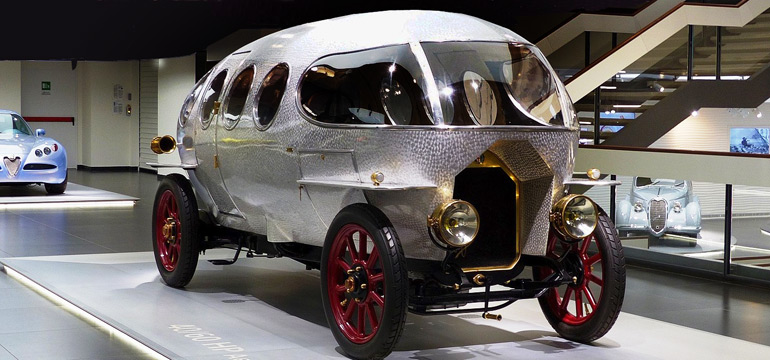
 1913
Alfa 40-60 HP 6L Aerodinamica Castagna, 1913
Alfa 40-60 HP 6L Aerodinamica Castagna,
|
ALFA finances going into First World War
were not very good and they a needed cash injection. This came in the form
of a take-over by a company 'Nicolo Romeo e Cia', who were manufacturers
of mining equipment and portable air compressors. So, in 1915, just as the
war had started, the ALFA Company was taken over, and car manufacture
ceased. The whole company production facilities were turned towards
military hardware for the Allied war effort; munitions, aircraft engines
and other military items that both companies already had considerable
experience in. Business prospered and grew during the war. In 1918 the
company was renamed 'SA Italiana Ing Nicolo Romeo e Cia' and had amassed
adequate extra finances to be able to branch out taking over
locomotive and carriage factories
in a number of locations in Italy. These were assimilated under the ALFA
name.
Car production at the original ALFA
factory in Portello resumed at the end of the war in 1920 with the
development of the ALFA 24, now renamed the 20'30 Torpedo. At the
same time the Company name was changed to incorporate the name of the new
owners and became 'Alfa-Romeo'. The pre-war successes in motorsport quickly
returned, which helped with the funding to perpetuate production of successful road and
racing cars throughout the 1920s.
|
 
|
|
It was during this period that Enzo
Ferrari was the Alfa-Romeo works driver. Enzo had started with a small
workshop manufacturing metal parts for local car companies, and this led
him to becoming a test driver for the CMN car construction company testing cars on
completion of manufacture. He was subsequently
promoted to become their racing driver. In 1920 he left CMN to join ALFA's
competition department as racing driver. There
he did very well for a couple of years but due to a number of deaths of
his friends and fellow racing drivers, he retired from driving in 1929 and took over ALFA racing team
management
naming it 'Scuderia Ferrari'. ALFA continued its involvement with cars and
backing until funds became a problem in 1933. Enzo decided however to
carry on on his own running his Scuderia, but in the late 1930s it was the
Germans who had the upper hand in motor car development. In the
following few years Ferrari battled on on his own the might of the German dominance of Auto-Union and Mercedes. In 1937 Scuderia Ferrari
was dissolved and Enzo returned to the Alfa's racing team, now named "Alfa
Corse". A year or so later, after a disagreement with Alfa's managing director,
Enzo left ALFA again in 1939 and founded Auto-Avio Costruzioni, a company
supplying parts to other racing teams. With the outbreak of World War II,
Ferrari's factory was forced to undertake war production for Mussolini's
fascist government. Following Allied bombing of his factory, Ferrari
relocated from Modena to Maranello. At the end of the war, Ferrari decided
to start making his own cars bearing his name, and founded Ferrari SpA in
1947. 20 years of independence ensued but by 1969 Ferrari was beginning the merger with Fiat having also had
unsuccessful similar talks with Ford. By the 1980s Ferrari was fully owned
by Fiat.
 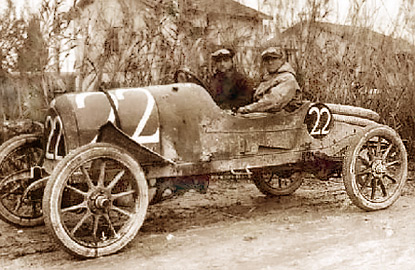
 Enzo Ferrari as 1918
Alfa-Romeo Works Driver Enzo Ferrari as 1918
Alfa-Romeo Works Driver
|
Going back to ALFA, in 1920, the bank
behind Nicolo Romeo e Cia' went bankrupt requiring the government to step
in to help the companies affected, which included Alfa-Romeo. Part of the
restructuring measures in 1928 was that the railway activities were
separated off, which made Nicolo Romeo resign in 1928. By the 1930s the
political landscape was changing dramatically in Italy with the rise of
Mussolini and the Fascists. Nationalisation of industry was taking over as
indeed was the case for government takeover of Alfa-Romeo. It was rather
paradoxically that during this period going towards the Second World War
that Alfa-Romeo automobiles were widely hailed as the finest racing and
sports cars in the world. But it was the Second world war that put an end
to the glory days when in 1944 the Alfa-Romeo factory was destroyed by
heavy bombing, temporarily ending production.
|
 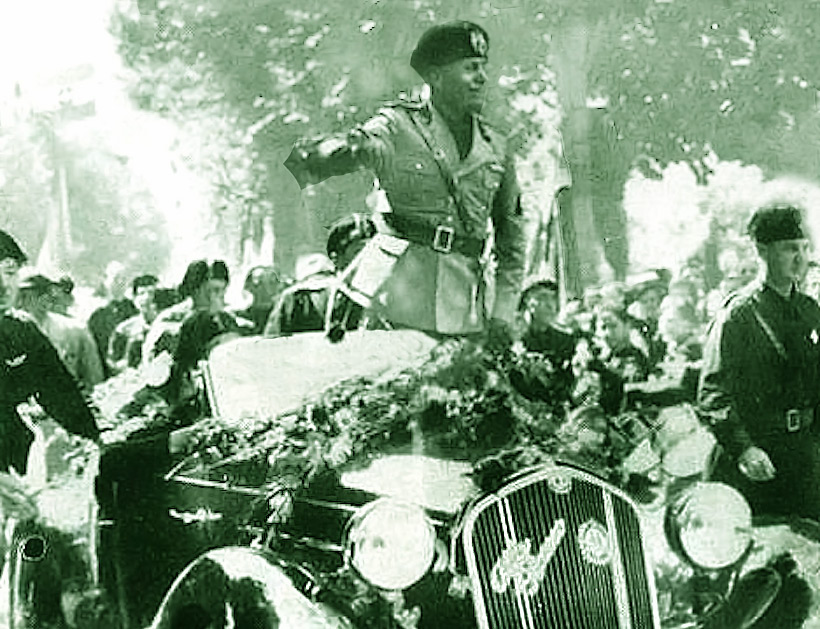
|
Fast forwarding, Alfa Romeo did not come
out of the war well but continued operating under Italian Government
control making some very interesting cars including the Giulietta, Giulia,
Alfasud and Alfetta. The Italian Government sold Alfa-Romeo to the Fiat
Group in 1986 where it has remained since. The Fiat Group has in the
meantime had a number of subsequent mergers and changes to currently being
Stellantis Europe, - part of Stellantis, comprising the Italian-American
conglomerate Fiat Chrysler Automobiles (FCA) and the French PSA Group (PSA).
|
| Post Script:
Our Veterans Expert Ariejan Bos
subsequently commented that the original picture image is too blurry and too
poor in resolution for a proper positive identification. He feels that some
allowance should be made for a possible divergence in identification. He
thought that some of the features of the car including the circular roundel
are possibly reminiscent of a 1912/13 Benz. The smaller Benz has a similar
arrangement of forked axle ends but the 8-18PS and 8-20PS models have a much
larger rad shell than is the case for the larger Benz. In the former case
the Benz emblem would have a much lower position on the shell than it has on
the mystery car. Unfortunately, the roundel emblem on the mystery photo is
too blurry to see if it is Benz or ALFA, and he knows from experience that
with this resolution it is impossible to determine whether it is the one or
the other. Only on this item do we disagree. I find it exceedingly difficult
to convince myself that the roundel of the car can be Benz. To me the
letters just do not align right correctly within the roundel, not even with
the Russian version of the roundel. While the other letters are debatable,
the letter N in Benz which corresponds to F in Alfa do not look to me to
compatible with the Benz shape but they do look more like the Alfa Shape.
The shape of the bottom of the N on the mystery car has a space that should
not be there because the three lines of the N should be in it. It almost
looks if the Z is one letter too early?
|
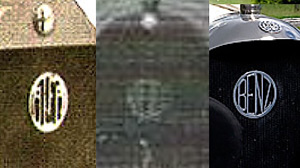
|
|
|
Go to Recent Venues Page
PICTURE GALLERY INDEX
|